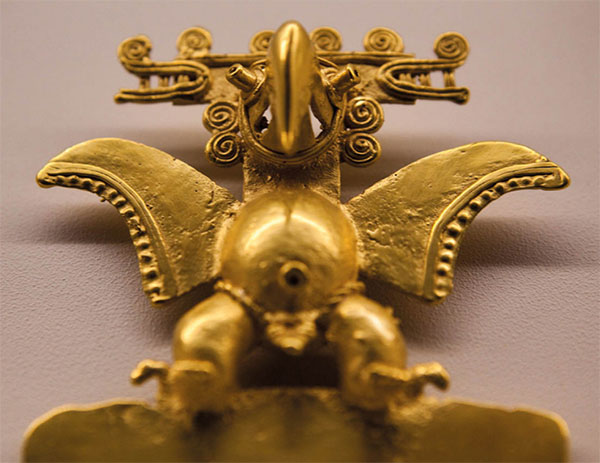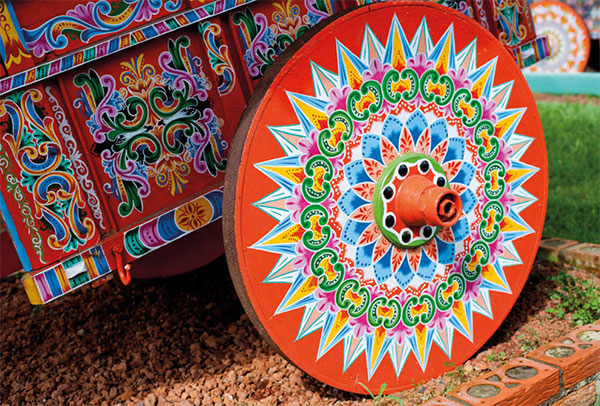The city center
The Plaza de la Cultura marks the heart of the city. The area around this large square is a popular meeting point for peddlers, artisans, street musicians – in fact, just about anybody and everybody. The pride of the square is the neoclassical Teatro Nacional A [map] (www.teatronacional.go.cr), modeled after the Paris Opera House and without doubt the finest building in San José, if not all of Costa Rica. The country’s top-quality National Symphony Orchestra performs here with illustrious international guest artists; their season begins in March. There are also daily tours where you can admire the marble, gold, bronze, tropical woods, crystal chandeliers, velvet drapes, and statuary. The ceiling fresco is famous and features an idyllic, if improbable, scene of coffee and banana pickers. Across from the National Theater is the Gran Hotel Costa Rica B [map] , restored to its 1930s glory and renowned as a meeting place for tourists who gather in its outdoor café, where musicians often entertain with marimbas.

Exihibits in the Museo del Oro Precolombino.
Corrie Wingate/Apa Publications
Beneath the Plaza de la Cultura is the Museo del Oro Precolombino C [map] (www.museosdelbancocentral.org; daily 9.15am–4.30pm). On the east side of the square in cool, darkened, cavernous rooms, the collection features more than 2,000 brilliant pre-Columbian artifacts made by the Indigenous peoples from the southwestern part of the country. Highlights include tiny half-man, half-bird figures, and erotic statuettes. Farther east, between avenidas 2 and 14 and calles 7 and 11, lies the Barrio Chino (Chinatown), the only one in Central America.
West of the plaza
A short walk west of the Plaza de la Cultura along Avenida 2 is the Parque Central D [map] , another great place for people-watching. The Gaudí-like kiosk in the center of the park was donated by the Somoza family of Nicaragua and sometimes hosts open-air concerts on weekends. At the northern end of the Parque Central, look out for the restored neoclassical facade of the Teatro Popular Melico Salazar.
Directly in front of the park is the huge Catedral Metropolitana E [map] (Mon–Sat 6.30am–6pm, Sun 6.30am–9pm). Notice the finely carved wood ceiling of the Chapel of the Holy Sacrament and its walls, so carefully adorned with flower motifs that it almost looks as if they have been tiled. The cathedral provides a refuge of peace from the hot bustling city, and the microphone-amplified midday Masses are always well attended.
Due north of Parque Central, along Calle 2, is the Correos F [map] (Central Post Office), in a grand old, ornate building that also houses the Museo Filatélico (Philatelic Museum; Mon–Fri 8am–5pm) and a pleasant café. Three blocks west of the post office, walking along pedestrian-only Avenida 1, you will find the renovated and much brightened up Mercado Central G [map] (Mon–Sat 6.30am–6.30pm), the city’s best market since 1881, where there are more than 200 vendors selling everything from old kitchen utensils to saddlebags, fresh fish, coffee and spices by the kilo, to religious icons.
North and east of the plaza
To get a feeling for the San José of old, take a walk in Barrio Amón, where some vestiges of elegance survive. Start at the Casa Amarilla (Yellow House), the ornate, Spanish-colonial-style home of the foreign ministry. Walk a block north to Avenida 9 and head west (left). You will pass by some elegant Victorian mansions, complete with gingerbread trim and stone lions guarding walled gardens.
For an urban view of Costa Rican wildlife, visit the enchanting Spirogyra Jardín de Mariposas H [map] (Spirogyra Butterfly Garden; www.butterflygardencostarica.com; Mon–Thur 9am–1pm, Fri–Sun 9am–2pm). One of the main aims of Spirogyra is to help rural women find alternative sources of income from field labor, by exporting butterfly cocoons to Europe and the US instead. Go on a sunny day when the butterflies are most active.
Across the street from the INS building is the former Fábrica Nacional de Licores I [map] (National Liquor Factory), which now houses an arts and cultural center, as well as the Ministry of Culture. Pop into the pretty courtyard and amphitheater (a venue for plays and concerts) which lead to another part of the complex, the Museo de Arte y Diseño Contemporáneo (www.madc.cr; Mon–Sat 9.30am–5pm; free on Mon), which mounts changing exhibitions with the latest in avant-garde art, sculpture, and photography.
The Central Valley
The Central Valley (Valle Central), or Central Plateau (Meseta Central), as it is often called, is strictly speaking neither a valley nor a plateau since it contains both kinds of landscape. The Central Highlands might be a more apt name for this area, only 24km by 64km (15 miles by 40 miles), where two mountain ranges meet. You will find rich, volcanic hills and river-filled valleys, with altitudes reaching up to 1,500 meters (4,500ft).

Fish stall, Mercado Central.
Corrie Wingate/Apa Publications
The countryside is beautiful and variable. The climate is salubrious. The air is sweet and soft. The people are generally friendly, dignified, and independent. Volcanoes, some still active, others dormant or extinct, rise up above the hills around the valley. Above them, a big sky is constantly changing – dark, charcoal rain clouds; intense, searing patches of blue; fluffy white cumulus; and rainbows galore. All come and go in quick succession. Day trips by bus or car, or with tour groups, can easily be arranged.
Alajuela and Heredia
As you descend by some 200 meters (660ft) into Alajuela 2 [map] , the country’s second-largest city, it becomes noticeably warmer. To relax, you can join the old-timers in the central park, amid an orchard of mango trees. Alajuela is the birthplace of Juan Santamaría, the young Costa Rican whose courage in helping to rout William Walker and his filibusteros from Costa Rica in 1856 is enshrined in national legend. The expanded Museo Histórico Cultural Juan Santamaría (www.museojuansantamaria.go.cr; Tue–Sun 9am–5pm; free), one block from the central park, tells his story.
Heredia 3 [map] (pop. 123,000) lies 11km (7 miles) north of San José and is known as La Ciudad de las Flores (The City of Flowers). The city was first settled in 1706 by the Spanish, long before San José was even thought of. Historically a bastion of coffee wealth, the city today is even more prosperous, with trendy new stores popping up, fueled by affluent suburbs housing professionals and Costa Rica’s burgeoning middle class.
Sarchí
For a half-day excursion of craft shopping and sightseeing around typical Central Valley coffee towns, head north through Alajuela toward Sarchí 4 [map] . The approach to the mountain town is unmistakable. Swirling, colorful decorative designs adorn practically every bus stop, bar, bakery, restaurant, and house. In the town’s central park in front of the wedding-cake white church, there is a giant painted oxcart, weighing in at 2 tons and delighting camera-toting tourists. Sarchí is a crafts center heavily geared toward the tourist trade, where you can see artisans painting traditional ox-cart designs and creating household furnishings out of tropical hardwoods. There are pleasant little roadside stands on the outskirts of Sarchí selling homemade candied fruits, honey, and fudge.

Characteristic Sarchi ox-cart designs.
Corrie Wingate/Apa Publications
Poás Volcano National Park
The most developed of all the parks is Parque Nacional Volcán Poás 5 [map] (daily 8am–3.30pm), a popular stop on the tourist trail. It is only 37km (25 miles) from San José on good roads leading through the city of Alajuela. Poás can become crowded and cloudy, so it is best to visit early in the day when views are better and before the throngs arrive. The cool freshness of the air as you ascend the mountain is invigorating, although it can get chilly and rainy.
A map of the nature trails is available at the Visitors’ Center, where there are nature exhibits, a gift shop, a cafeteria, and restrooms. If the weather closes in, as it often does up here, at almost 2,740 meters (9,000ft) above sea level, the Visitors’ Center is a good place to hunker down and warm up. From a lookout point above the crater, there is an overview of the volcano, which in 1989 shot ash well over a kilometer (a half-mile) into the air. The main crater, which is 1.5km (1 mile) wide and 300 meters (1,000ft) deep, is one of the largest in the world. Poás rarely has violent eruptions and is one of the more accessible active volcanoes on the continent. It is active in 40-year cycles and is currently producing acid-like rain and sulfurous gases.